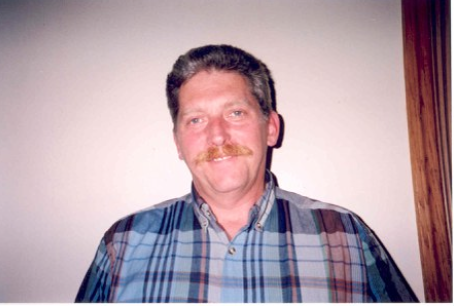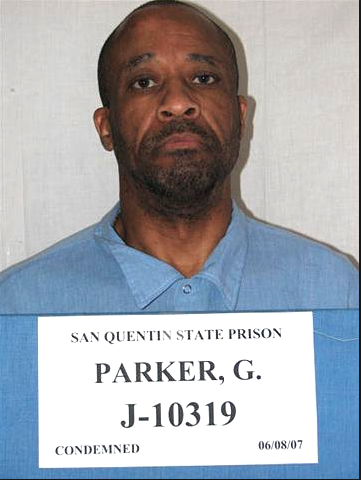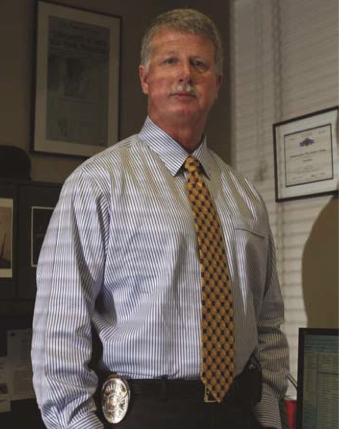Editor’s note: The “Bedroom Basher” case was featured on the television show, “The Perfect Murder,” on Wednesday, July 22. It is the second time the infamous case was profiled for television. Retired Tustin Lt. Tom Tarpley, who was integral in the case, tells his story of how he coaxed a confession from a serial killer and helped set an innocent man free.
The tall black man with wide shoulders, thick arms and dark eyes entered the austere room.
Retired Tustin Lt. Tom Tarpley, 51, remembers those eyes. He calls them “a killer’s eyes.”
The prisoner was just two weeks away from being released after serving time for the 1980 kidnapping and rape of a 13-year-old Tustin girl.
The teen had an impeccable memory and led police to the killer’s location at the El Toro Marine Air Station.
But Tarpley wasn’t there to talk about the rape case.
Tarpley, along with two Costa Mesa detectives, wanted to interview the man as a suspect in several unsolved murders.
They believed the killer was the “Bedroom Basher” — a grotesque moniker given to a man who fatally beat and then raped five women in Orange County in 1978 and 1979.
At times, the prisoner was detached and vague, but a line of questioning that linked two seemingly unrelated cases sparked something in the man with the dark eyes.
In that interview, on June 14, 1996, Tarpley heard the prisoner say the words that took the breath from his chest:
“There’s a man (in prison) for a murder I committed.”
…
There are conflicting reports on how the night of Sept. 20, 1979 went.
Dianna Green said she quarreled with her husband. Kevin Green said that never happened.
The young couple was known to fight and, on occasion, the police were called.
In the early morning hours of that day, Kevin Green, 21 at the time, told police he left their ground-floor Tustin apartment to drive to Jack-in-the-Box on Newport Avenue.
The line was long, so Kevin Green drove to another location further away.
Dianna, 20 at the time and 9 months pregnant, opted to go to bed.
Kevin Green told police when he returned home, he found his wife unconscious in bed with a wound to her head.
It looked like a gunshot wound, but doctors would later determine Dianna Green was hit with an object with such force her head split in a star-shaped pattern, similar to the way a bullet wound would look.
Dianna also had been raped and strangled.
She survived, but suffered brain damage and memory loss.
Her unborn baby died several hours later.

Kevin Green was wrongfully convicted of murdering his unborn daughter and trying to murder his wife. He spent 16 years in prison before a serial killer confessed to the murder. Green reportedly now lives in Missouri. Photo courtesy the Innocence Project.
Kevin maintained his innocence but evidence and statements from Dianna convinced detectives otherwise.
He was arrested for the murder of his unborn baby and the assault on his wife.
Dianna told police the last thing she remembered was her husband entering the room then being hit in the head.
Among the evidence detectives collected were bodily fluids for a rape kit.
In 1979, technology allowed police to identify blood types, but that was the extent of forensic science.
Kevin Green’s blood type matched the fluids found on Dianna — Type O.
He was convicted of second-degree murder for the death of his unborn baby and attempted murder of his wife, and was sentenced to 15 years to life in prison.
Five other women in Orange County were attacked in a similar way that Dianna Green had been — beaten, raped and strangled.
Only in those cases, none survived.
And those cases remained unsolved for decades.
…
Tarpley joined Tustin PD in 1989 and in the 1990s worked as a detective in the crimes against persons unit handling robbery and homicide investigations.
After attending a training session in San Diego that introduced him to an online database that would allow police to use forensic samples from unsolved cases and compare them to known offenders, he got excited.
Tarpley asked about exploring some cold cases and Lt. Bill Fisher, who is now retired, urged the detective to check out the Debra Kennedy case.
Debra Kennedy, 24, was viciously murdered in her ground-floor Tustin apartment in October of 1979.
Her sister found her naked body on the sofa. Debra had been raped and bludgeoned to death.
Tarpley combed through the immense case file.
There were notes about the “Bedroom Basher” — an unknown serial killer who would break into apartments, raping and murdering Orange County women.
There were also notes about the Dianna Green case.
Tarpley noted Kennedy and the Greens lived just about a mile apart.
Then Tarpley came across a rape kit in the Kennedy case. He sent its contents to the Orange County Sheriff’s Department Crime Lab.
The detective learned the Orange County District Attorney’s Office was leading the effort to process old forensic evidence to find closure in dozens of cases.
Costa Mesa police had also submitted evidence on two of their unsolved murders — two women who had been raped and beaten to death.
The cops waited.
In June of 1996, Tarpley received a phone call from the Crime Lab.
There was a hit.
Three, actually.
“At that time, there were not a lot of known offenders in the database,” he said. “It was a big deal.”
DNA evidence on Tustin’s unsolved murder and two of Costa Mesa’s came back as belonging to Gerald Parker, an ex-Marine who lived on the El Toro base but now was serving time for raping the 13-year-old.
The detectives partnered with the DA’s office to come up with a plan.
As they prepared to head to Avenal Prison in King’s County, prosecutor Mel Jensen stopped Tarpley.
“When you go and talk to Parker, could you just go down the road with him and ask him about the Green case? I have doubts about Kevin Green’s guilt.”
Tarpley said the request surprised him.
“You don’t hear DAs say that very often,” he said. “It made an impression on me.”
He told Jensen: “When the time comes, I’ll hit him on it.”
…
At Avenal prison, the Costa Mesa detectives went first.
They questioned Parker on their two cases.
Parker gave them some rendition of: “I don’t think I did it. I don’t remember.”
Then it was Tarpley’s turn.
When the detective entered the room, he was surprised at Parker’s size.
Tarpley, who is tall by anyone’s standards, felt small next to the ex-Marine.
He noticed Parker’s wrists seemed pinched in the tight handcuffs, so he removed them.
Tarpley searched Parker’s dark eyes for any sign that the convicted rapist might soon confess to also being a murderer.
But Parker stayed flat with his responses. He was polite, but monotone.
Then Tarpley switched gears.
“Do you know anything about the Kevin Green case?”
Parker perked up, his dark eyes lightened slightly.
“As soon as I brought up Kevin Green, his whole demeanor changed,” Tarpley said.
Parker rattled off some details about the case — odd for someone who had spent nearly a decade in prison.
“It was clear he wanted to talk about the case,” Tarpley said. “I just put that aside for a second and went over the Kennedy murder.”
As the hour-long interview wound down, Tarpley said Parker’s reaction to the Green case nagged at him.
He nudged Parker a little more.
“I told him, ‘There comes a point in your life that whatever you’ve done wrong, you have the chance to do the right thing. You have the chance to atone,” Tarpley said. “This is your moment. You’re never going to get this moment again.”
Parker asked if the Costa Mesa detectives were still around. He then asked to use the bathroom.
Tarpley’s heart rate started to pick up pace.
“I think he’s going to confess,” Tarpley told the Costa Mesa detectives.
When Parker came back, he sat tall in his chair.
“Do you have something you want to tell us?” Tarpley asked.
“Yes I do,” Parker said. “There’s a man (in prison) for a murder that I committed.”
Said Tarpley, recalling that day: “I have had a lot of things happen to me in my life, but that literally knocked the wind out of me. I did not expect that.”
Seconds ticked slowly. Tarpley felt frozen.
He forced himself to quickly process what had just happened.
“I thought, ‘OK, now we’ve got to get down to business. This is what you get paid for,’” he said.
Parker recounted his attack on Dianna Green.
He talked about how he watched Kevin Green leave the apartment and waited until he drove away.
Parker entered the apartment through an open kitchen door and noticed a Marine Corps commendation framed in the living room.
That commendation was captured in the crime scene photos, Tarpley said.
Parker clutched a 2×4 and entered Dianna’s bedroom.
Tarpley said he believes Dianna mistakenly believed she was waking to her husband coming home.
Because her bedroom was dark, Parker was backlit with light from the living room — making him appear as a shadowy figure.
She was expecting her husband, not an intruder.
That coupled with brain damage suffered in the assault may have led her to misidentify her attacker, Tarpley said.
Tarpley said Parker’s account of the attack had details he wouldn’t know unless he had been there.
He headed back to the department to search for any forensic evidence that might help corroborate the case.
Tarpley had little hope a rape kit from an adjudicated 1979 case would still be stored somewhere.
“With those types of cases, you generally get rid of evidence,” he said. “You have to believe God was on our side — they found that rape kit.”
The bodily fluids identified Parker as the rapist.
The tests also showed he was blood type O — just like Kevin Green.
But there was more work to be done.

Gerald Parker, the convicted serial killer known as the “Bedroom Basher”, still sits on death row today. Photo courtesy the California Department of Corrections.
…
Tarpley’s next move was visiting Kevin Green at Soledad State Prison.
The detective needed to ensure the two ex-Marines weren’t partners in the vicious beating.
He took his time with Kevin.
The former Marine entered in prison-issued denim jeans and a long-sleeved light blue shirt.
His eyes were soft, not like Parker’s, but they narrowed when they saw Tarpley.
“Before I told him anything, I just had to make sure he had nothing to do with it,” Tarpley said.
He told Kevin Green he wanted to hear the story of that night in 1979.
Kevin’s story barely faltered from the first account he told detectives decades earlier.
“To me, that was really important,” Tarpley said. “If you lie, it’s hard to keep that lie straight.”
Once satisfied Kevin Green had nothing to do with the attack, Tarpley shared the news.
“There’s a man in another prison who has confessed to killing your baby. You’re going free.”
Green slumped in his chair, then filled with joy.
“I had to calm him down, he was just bouncing off the walls,” Tarpley said. “The room lit up for Green.”
After serving 16 years in state prison for a crime he didn’t commit, Green was exonerated.
Parker was convicted in October 1998 of raping and attacking Dianna Green and killing her unborn child.
Parker was also convicted of murdering five women — Sandra Kay Fry, 17, of Anaheim; Kimberly Gaye Rawlins, 21, and Marolyn Kay Carleton, 31, both of Costa Mesa; and Debora Kennedy, 24, of Tustin.
Gov. Gray Davis in October 1999 awarded Green $620,000 for his wrongful conviction and prison sentence.
In January 1999, Parker was sent to Death Row, where he remains today.
Tarpley said it was a team of people including persistent prosecutors and diligent crime lab investigators at the OCSD who helped exonerate Kevin Green and find the true murderer.
“I did my job, but I’m not a key player in this thing,” he said. “This case is one of the better examples of everything that’s right about law enforcement.
“Were there mistakes made? Absolutely. But in the end, the right thing was done because everybody did their job.”
 Behind the Badge
Behind the Badge



